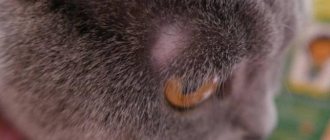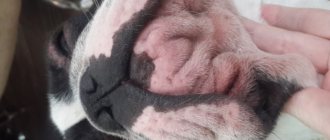Main symptoms
Discharge from a dog's eyes in the form of pus and excessive tearing are signs of the development of an infection in the body. If a symptom appears, you should monitor the general condition of the dog.
Associated symptoms:
- Discharge of a thick yellow and gray liquid.
- Itchy skin, redness on the ears, around the eyes.
- Dry and hot nose.
- Inflammation of the eyeball.
- An increase in the animal's body temperature.
- The dog becomes lethargic and has no appetite.
All these symptoms indicate the presence of a disease that requires urgent diagnosis. It is necessary to examine all mucous membranes, take blood and urine tests.
Causes
Discharge from the eyes can indicate infection, allergies, parasites and diseases of the internal organs.
Provoking factors:
- foreign body, speck;
- conjunctivitis;
- viral and fungal infections;
- parasites;
- irritation;
- eyeball injury;
- diseases of the endocrine system;
- exposure to toxins.
Any eye inflammation can lead to vision loss, so accurate diagnosis and prompt treatment are necessary.
Main reasons:
- With prolonged allergies, your pet may experience purulent discharge from the eyes. An environment is created for the proliferation of harmful bacteria.
- Fungal diseases are often local in nature. The dog's eyes become sour and tearfulness increases.
- Viral diseases are characterized by the rapid development of the disease. The eyes fester, the body temperature rises, the stool changes.
- Parasites such as fleas, ticks and worms cause allergies.
- Diseases of internal organs, endocrine system. The most common cause is diabetes mellitus and liver disease.
- Chronic diseases of the tear ducts.
Any disease has several symptoms at the same time . Associated causes may not be immediately noticeable, so if the eyes become sour, you should monitor the animal.
Allergic reactions
An allergy in dogs is a reaction of the immune system to an irritant.
It can occur due to eating poor quality food or inhaling toxins. The dog develops itching and dandruff on its fur. Most often, symptoms appear during the warm season.
When an allergy occurs, the cause of its occurrence is first identified. In dogs it is more often food-borne. Owners will have to carefully review the animal’s diet, eliminating provoking foods.
Bacterial infections
In addition to sour eyes, bacterial infections cause a number of unpleasant symptoms in your pet. The disease is difficult for animals and is accompanied by depression. The dog becomes lethargic.
Symptoms in the presence of bacteria:
- the animal does not eat;
- lethargy, apathy;
- loose stools;
- fever;
- increased body temperature;
- vomiting, heartburn;
- dyspnea.
The presence of all signs at the same time indicates an advanced form of the disease. You will need quick help and medication.
Parasites
Worms, ticks and fleas affect the functioning of the body and cause allergic reactions. There is a decrease in immunity . The eyes turn sour and purulent discharge appears. When bitten, the dog may itch and damage the organ of vision with the claw.
Fungal diseases
Fungi affect not only the eye area, but also the skin. The fur begins to fall out in large quantities. An unpleasant odor appears from the ears. With fungal infections, one eye may become sour - this depends on the location of the lesion.
Conjunctivitis
Purulent conjunctivitis is dangerous for dogs.
Pet owners will immediately notice symptoms characteristic of the disease:
- yellowish discharge;
- red tint of the eyeball;
- accumulation of pus;
- eyes water and itch.
The disease has 3 stages. At the last stage, the animal weakens, cannot open its eyelids, appetite disappears, and weight loss occurs.
Physiological reasons
Unhealthy discharge from the eyes also occurs for physiological reasons:
- Trauma (bruise, burn). A dog can damage its vision during play or by sticking its muzzle where it shouldn’t. It may be splashed with boiling water, chemicals or other aggressive liquid.
- Entry of a foreign body. Dogs run low to the ground and are more susceptible to dust, debris and other particles getting into their corneas.
- Distichiasis. Pathology characterized by the growth of fur (hairs) on the inside of the eyelids. It can be removed surgically.
- Trichiasis. Eyelashes grow in the opposite direction (inward), which causes constant irritation of the cornea. It can also be solved surgically.
If one eye of a dog turns sour, then the reason is most likely a physiological disorder or mechanical damage.
Carefully examine your pet; you may notice a speck of dirt or abnormally growing eyelashes or hairs.
Treatment
Comprehensive eye treatment includes hygienic treatment, nutritional review, and medication. What to do if your dog has sour eyes:
- Consult a doctor for a diagnosis.
- Provide first aid to your pet.
- Eliminate allergenic foods.
- Follow your veterinarian's recommendations.
If necessary, the dog is given a special collar to protect its face. Be sure to follow a diet. Products that cause fermentation in the gastrointestinal tract are excluded from the animal’s diet.
First aid
Before going to the veterinarian, you should give your pet some help. It includes eye treatment at home.
The procedure is carried out using:
- boiled water;
- diluted furatsilin;
- freshly brewed black tea;
- decoction of chamomile, St. John's wort or calendula.
Apply the product to a cotton pad and gently wipe from the outer corner to the inner. Use a clean cotton swab for each eye .
Foreign body removal
If a speck gets into your dog's eye, it must be removed. After removal, it is recommended to wash your eyes with antiseptics 3 times a day. For this purpose, furacilin diluted in water and potassium permanganate are used.
Use weak solutions so as not to damage the mucous membranes. Rinsing is done until the inflammation subsides.
Why can dogs' eyes fester?
Most often, dog owners turn their pets to veterinarians for help due to eye disease. Everything happens in stages, the eyes can:
- tear;
- turn sour;
- fester.
Such problems can lead to serious consequences . It is very important to pay attention to this in time, find out why this is happening and provide timely assistance to the animal. There are several reasons for this condition of the ocular mucosa:
- getting dust, dirt, foreign bodies into the eyes;
- infections;
- injuries;
- allergic reaction;
- systemic diseases;
- anatomical features.
If purulent discharge appears in the dog’s eyes, then this is due to conjunctivitis of various origins.
Drops
Medicines should be dripped into the eyes after hygiene procedures, so as not to reintroduce the infection. Improvements will be noticeable after the first procedure.
How to treat:
- Levomycetin drops;
- Desacid.
Levomycetin
Drops are allowed in the absence of allergic reactions. The procedure is carried out 3-4 times a day. They are used with the permission of a veterinarian, as they are classified as antibiotics.
Dosage:
- for puppies 0.2 ml per 1 kg of weight;
- adult dogs: 2 drops in each eye.
Desacid
Antimicrobial drops are allowed for dogs. These drugs have a quick effect.
Dosage:
- 2-4 drops in each eye;
- for prevention, 1-2 drops.
The course of treatment lasts at least 7 days. Allowed for puppies, adults and pregnant dogs.
What to do if your dog has sour eyes, causes, symptoms and treatment
A common cause of concern for dog breeders is sour eyes in their pets. And this concern is not unfounded, since sour eyes may indicate more serious health problems with your four-legged friend. To understand what needs to be done in such a situation, you should know the causes of the illness. Symptoms
Eye inflammation in dogs can lead to vision loss, and it is very important to identify the disease early and treat it correctly.
First, you need to figure out what is meant by the concept of “souring”, what symptoms indicate this illness? Symptoms include: • leakage of viscous, opaque liquid into the corners of the eyes; • appearance of thick, cloudy or clear fluid in the eyes; • accumulation of purulent discharge, leading to sticking of the eyelids after sleep. Causes of sour eyes
The number of reasons can be very wide.
When pus appears on your pet's eyelids, we can talk about such a common disease as conjunctivitis. This disease is contagious, but harmless if treated promptly. There can be many reasons for the appearance of various fluids in the eyes. Here are the main ones: • Eye injury. Eye injuries occur quite often, especially if the pet likes to run near bushes. • Foreign body. Anything can get into the mucous membrane of the eye: sand, earth, sawdust and other small objects. An x-ray of the animal may be required, which can be done here • Oral diseases. Since the mucous membranes in the body are interconnected, discharge from the eyes can be observed in various diseases of the oral cavity. • Allergies. Allergic reactions also occur in pets. They are accompanied by itching and inflammation of the mucous membranes. • Infection or weakened immune system. The cause of the discharge may be an incipient illness or simple hypothermia. • Bacterial damage. The discharge is caused by bacteria such as staphylococcus and streptococcus. In this case, the pet may also experience malaise and photophobia. • Viruses. Often conjunctivitis is accompanied by diseases such as rabies and enteritis. • Worms. This is another reason for sour eyes, in which the discharge has a whitish tint and, when dried, sticks the eyelids together. • Structure of the eye. There are dog breeds that are prone to conjunctivitis. Treatment
If you have no experience in caring for dogs, then it is better not to start treatment yourself, but to consult a specialist. The veterinarian will be able to take all the necessary tests from the mucous membrane of the pet’s eye, determine the form and type of the disease and prescribe the appropriate treatment. It’s better not to delay so that you don’t need a veterinarian surgeon. If a trip to the doctor for some reason cannot take place, and you decide to carry out the treatment yourself, then you need to know its basic principles: • First of all, you need to keep your eyes clean. To do this, they are washed with a solution of furatsilin (one part of furatsilin - 5000 parts of water). This solution can be purchased ready-made at a pharmacy. It is also recommended to wipe your eyes with a cotton pad soaked in strong tea. If your pet does not have allergies, then such rinses can be done with a decoction of calendula or chamomile. • To treat this disease, drops are used that are prescribed by a specialist. If it is not possible to take your dog to a doctor, you can consult a veterinarian by phone. The most commonly prescribed drops are ciprovet, tobrex, and chloramphenicol. The course of treatment lasts 1-2 weeks, 1-2 drops, 4-6 times a day. You should not delay the treatment of this disease, since conjunctivitis in an advanced form can become chronic, which will bring a lot of problems to the pet and its owner. On the contrary, timely recognition of the disease and timely treatment will help you quickly forget about such a nuisance as sour eyes. So, if necessary, contact the veterinary clinic https://berloga.vet/
Copyright Muz4in.Net © - This news belongs to Muz4in.Net, and is the intellectual property of the blog, is protected by copyright law and cannot be used anywhere without an active link to the source. Read more - “about Authorship”
Did you like the article? Just follow the advertisement after the article. There you will find what you were looking for, and for us a bonus...
By
How to rinse
Hygiene procedures are carried out in the morning. They include not only treatment, but also instillation of medications if treatment is being carried out at this time.
How to wash your dog's eyes at home:
- Apply a product, such as chamomile infusion, to a clean cotton swab.
- Gently apply it to the eye socket.
- After 2-3 minutes, remove the discharge with smooth movements.
- Wipe again with a clean disc.
Both eyes of the animal are treated in this way. Movements should not cause discomfort to the pet.
Folk remedies
Medication treatment is not always allowed for animals. In this case, folk methods of treating eyes from pus will help.
Folk remedies:
- Strong black tea. They wash their eyes.
- Fresh aloe juice diluted in water. Proportions: 1 tbsp. juice per 200 ml of water.
- Freshly squeezed carrot juice with vegetable oil (added to food). This remedy helps improve immunity.
If there are allergic reactions, you should review your dog’s diet and eliminate harmful foods. Dishes must be fresh.
Treatment of the disease
During the first visit, the veterinarian will have to examine the pet and prescribe laboratory tests to determine whether the pet has an infection. If an animal has a swollen eye, the doctor will have to wash the dog’s eyes from pus with a solution of furatsilin or another similar substance. Having the examination results in hand, he will prescribe conservative treatment for the animal. It is selected depending on the reason that caused the appearance of pus:
- If an allergic reaction to a specific pathogen occurs, the animal will be prescribed antihistamines.
- If your pet has been found to have worms or mites, he will be prescribed antiparasitic treatment. It is carried out at home using general medications or special shampoos, gels or sprays.
- For mechanical injuries, therapy will be limited to the use of local drugs: antimicrobial drops, solution for washing the eyeball, ointments that will need to be placed behind the eyelid.
- If there is a bacterial infection, your pet will be prescribed antibiotics. To eliminate severe swelling, the dog will be given injections of novocaine or hydrocortisone. To relieve acute symptoms of the disease, the doctor may prescribe local antimicrobial drugs. They should be placed behind the animal's eyelid several times a day.
- In case of a viral infection, the dog will be prescribed antiviral agents, vasoconstrictor drops, and medications to strengthen the immune system. Puppies may be prescribed special supportive care if their lives are in danger.
Further treatment of the sick individual is carried out on an outpatient basis. Only in the presence of serious pathologies, accompanied by the risk of rapid development of complications and death of the pet, can it be admitted to the hospital.
While undergoing therapy, the dog’s owners need to ensure that it eats well, scratches its eyes as little as possible (a special collar can be used for this purpose), and does not come into contact with other animals while walking. His bedding and toys must be washed well and treated with an antibacterial agent.
With timely consultation with a doctor and the correct selection of treatment, it is possible to cope with such a problem in a few weeks.
Video: what to do if your dog’s eyes fester and how to treat it at home?
Prevention measures
Preventive measures will make it possible to avoid sour eyes. Particular attention should be paid to breeds with long hair and flat faces .
Prevention measures:
- Treat eyes daily. To do this, just wipe them with a cotton pad soaked in boiled water.
- Monitor the animal's diet. Avoid fried, salty and sweet foods.
- Trim long hair in the eye area.
- Avoid contact with stray animals.
- Treat your dog for fleas and ticks.
- Provide the animal with a clean place to sleep and eat.
- If a foreign body gets in, it must be removed immediately.
- Visit your veterinarian regularly to rule out diseases of the internal organs. It is especially important to treat the genitourinary system.
Hygienic procedures are selected individually for each breed. For short-haired cats, it is enough to wash their eyes and monitor their condition. Longhaired cats have their fur cut monthly.











